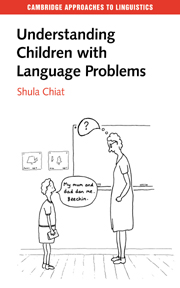Book contents
- Frontmatter
- Contents
- Acknowledgements
- Glossary of text conventions and symbols
- Introduction
- Part I Problems with words
- Part II Grappling with verb structure
- Part III Missing function morphemes
- Part IV Hidden meanings, baffling meanings
- 13 The roots of meaning
- 14 ‘[æ] you don't tell nobody this?’: strengths in pragmatic processing
- 15 ‘I can speak Chinese. But I can't speak Chinese’: problems in pragmatic processing
- Endpoint and springboard
- Further reading
- References
- Index
14 - ‘[æ] you don't tell nobody this?’: strengths in pragmatic processing
Published online by Cambridge University Press: 05 September 2012
- Frontmatter
- Contents
- Acknowledgements
- Glossary of text conventions and symbols
- Introduction
- Part I Problems with words
- Part II Grappling with verb structure
- Part III Missing function morphemes
- Part IV Hidden meanings, baffling meanings
- 13 The roots of meaning
- 14 ‘[æ] you don't tell nobody this?’: strengths in pragmatic processing
- 15 ‘I can speak Chinese. But I can't speak Chinese’: problems in pragmatic processing
- Endpoint and springboard
- Further reading
- References
- Index
Summary
Eamonn, at 6, and Ruth, at 10, are sometimes hard to understand, as we saw when we met them in previous chapters (see chapters 6 and 12). They often produce words which the listener doesn't recognise. In full flow, they can leave the listener completely at sea with their meaning. On other occasions, their utterances are quite clear, but fragmented and lacking some of the forms that sentences demand. Where enough words can be recognised, the listener gets the gist of what they are saying, but may still be in the dark about certain details which we expect in language. The listener might gather who the children are talking about, what happened to them, but be confused about whether it has happened, may happen, or will happen. The listener may know they are asking something about an event, but not be sure whether they are asking who was involved, where it occurred, or when. Consequently, conversations with Eamonn and Ruth are not as smooth as with other children of their age: their conversational partners often find themselves confused or at cross purposes, and the conversation has to backtrack to get back on course. And yet these children are perceived as bright, on the ball, responsive and participating appropriately in conversations. Despite the considerable obstacles to communication, the gut feeling of the listener is that the meanings they have in mind are normal. What is the basis for that feeling? What is the evidence that they have access to the normal range and complexity of experience on which meaning is built, even if these are not reliably encoded in their language?
- Type
- Chapter
- Information
- Understanding Children with Language Problems , pp. 243 - 250Publisher: Cambridge University PressPrint publication year: 2000

